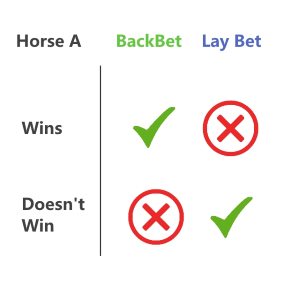Lay betting is one of the more common alternatives to traditional betting, and for those who carry it out successfully, it can be a very profitable practise. But what is a lay bet and how do you go about placing one?
What Is a Lay Bet
There are many different aspects to this practise but to begin with, it’s important to understand exactly what it means so here is lay betting explained in its basic form. Simply put, when a lay bet is made, the staker is actually betting on the outcome to lose. So, if they are laying a horse, then they expect it to lose the race.
Numerous Options for Lay Betting on the Betfair mobile app
The practise of lay betting is most common in horse racing, but it can be applied to any sport from football to golf, to tennis and many more. This way of approach actually dates back to the birth of betting, before the first sets of bookmakers even came into existence. Think of the early days of horse racing and a wager between two racegoers. One would have said ‘I bet this horse will win’ while the other will accept the wager, effectively betting on that horse to lose.
The practise has been carried out on an informal basis for centuries, but since the advent of the internet, matters have become more structured.
Who Will Take My Lay Bet?
A conventional bookmaker has no interest in lay betting in any form. Their sole purpose is to accept bets for straight winners. This is called a back bet, and you are simply staking on your selection to win the match / race, etc.
Most punters don’t go beyond the art of backing a winner so how does anyone place a lay bet? The answer lies in any of the betting exchanges that have been made available in the digital age. When any player signs up and logs on to an exchange, there are two available options. First up is the traditional back bet but there is the option to lay the outcome – i.e., to bet on the selection to lose.
 This forms part of the most basic of lay betting strategies, and for anyone looking to get involved for the first time, this is a logical place to start. A betting exchange is worth considering because prices for back bets are often higher than a traditional sportsbook, but this is where you will find those lay options.
An exchange can do this because it is relying on its customers to set the betting odds. An account holder is effectively putting up their own money, and for lay betting on the exchange, it is the individual that pays you should your stake come in.
This forms part of the most basic of lay betting strategies, and for anyone looking to get involved for the first time, this is a logical place to start. A betting exchange is worth considering because prices for back bets are often higher than a traditional sportsbook, but this is where you will find those lay options.
An exchange can do this because it is relying on its customers to set the betting odds. An account holder is effectively putting up their own money, and for lay betting on the exchange, it is the individual that pays you should your stake come in.
Many lay bettors concentrate solely on lay bets for single outcomes, but there are advanced techniques that could lead to better profits. So, know you know the answer to the question “what is a lay bet”, we can move on and look at those techniques in greater detail.
How to Back and Lay
Moving on from the basic method, punters have the option to Back and Lay. This, as the name suggests, involves placing two bets – a back bet for the win doubled up with the lay bet to lose. At first glance, it would seem that by making two bets there is no scope to make a profit, but if the technique is carried out correctly, a return can be guaranteed.
Match Betting
We’ll firstly look at matched betting which is the process of harnessing free bet offers from the sportsbooks in order to make a profit at the exchanges. Let’s say you claim a sign-up bonus that gives you a £10.00 free bet token in return for a qualifying bet of the same amount.
In the first instance, you would stake £10.00 at the sportsbook and then lay at the exchange, and here, we are aiming for just a small loss. Now, your free bet token has been made available, so you repeat the process of a back and a lay bet. This time, because you have only staked £10.00 of your own money – plus a freebie – a profit is certain provided you have done the maths correctly.
This is another popular lay betting strategy, and there are a number of free bet offers published by the bookies every week. Matched betting can be finite as these deals can dry up while mistakes involving calculations can be costly, but this is definitely a way where a lay bet can lead to a profit.
Shop It Around
One of the lesser-known lay betting strategies is commonly known as ‘Sharbing’. This involves visiting a physical betting shop, placing a back bet at certain odds and then going online via a mobile phone and laying it off at the exchange.
Punters often visit several shops in the area in order to carry this out, but it may be wise to restrict this activity. Branch staff talk to each other, and some ‘Sharbers’ have reported having their bets refused by the end of the day. However, it’s a practise that works for some people so it can certainly be considered.
Alternatively, with betting exchanges being volatile at times, it is possible just to sit at home and monitor prices without having to leave the house. Professional lay bettors often take this approach as, by staking certain amounts on different outcomes of the same event, a profit becomes more likely.
 These methods are less about sports analysis and more about mathematics, so it is important to do all of the calculations correctly and not make mistakes. There are software programmes and online calculators where players can input respective odds, and the machines will tell you how much you can stake, so it is possible to ‘outsource the work’.
Speed of thought is still required as is speed of action because odds can change quickly, particularly at the exchanges which are vital to lay betting so don’t delay once a likely back / lay has been identified.
These methods are less about sports analysis and more about mathematics, so it is important to do all of the calculations correctly and not make mistakes. There are software programmes and online calculators where players can input respective odds, and the machines will tell you how much you can stake, so it is possible to ‘outsource the work’.
Speed of thought is still required as is speed of action because odds can change quickly, particularly at the exchanges which are vital to lay betting so don’t delay once a likely back / lay has been identified.
Lay In-Play
We’ve answered the question what is a lay bet in terms of ante post betting, but for those who want to cross to live play, this is where big profits can be made. As we all know, in-play betting is a volatile but potentially lucrative alternative to pre-match staking.
 Let’s say you have a football team priced at Even Money to win a game before a ball is kicked. Ten Minutes into the game, they may have gone 1-0 down, and their in-play odds then drift to 2/1. This may be a good time for punters to act, particularly if they feel that the team that has gone behind are slow starters and tend to improve as a game develops.
In-play staking by itself can be a profitable pastime, but when coupled with live lay betting, there are ways in which you can guarantee a return. The exchanges are especially active during a big football match and odds are changing almost by the second. With individual customers effectively setting the lay prices, it is possible to get some excellent value.
Let’s say you have a football team priced at Even Money to win a game before a ball is kicked. Ten Minutes into the game, they may have gone 1-0 down, and their in-play odds then drift to 2/1. This may be a good time for punters to act, particularly if they feel that the team that has gone behind are slow starters and tend to improve as a game develops.
In-play staking by itself can be a profitable pastime, but when coupled with live lay betting, there are ways in which you can guarantee a return. The exchanges are especially active during a big football match and odds are changing almost by the second. With individual customers effectively setting the lay prices, it is possible to get some excellent value.
Once again, it’s a case of being able to act quickly and work out mathematical equations, but there is software that can be purchased. These programmes can work out the sums for you and tell you how much you need to stake along with the amount of profit you can expect once the outcome is settled. Players can even purchase software that alerts them to back and lay in play bets. This is one of the most advanced lay betting strategies, but it’s also very popular among serious punters as this is where the big profits can be made.
In Summary – Lay Betting in a Nutshell
Lay betting takes many forms so while there is a simple answer to the question what is a lay bet, there are many ways in which the practise can be approached with online sportsbooks and exchanges. In easy terms, when a bettor lays a horse, a football team, a tennis player or whatever, they are expecting their pick to lose. Lay bets are common at a betting exchange, and it is easy to sign up and place a single stake on a losing selection, but it is possible to make bigger, and in some cases, virtually certain profits by combining a back and lay system.

In this guide we have lay betting explained, and we’ve also outlined the various strategies that you can use. Some of them have a higher degree of probability than others, but all of them carry some form of risk, whether it’s matched betting, sharbing or back and lay in play, so it’s recommended that players carry out extensive research and start by using small stakes before getting fully involved.
This is where betting began, and in the digital age, lay bets are thriving as an alternative to traditional staking and they provide an option could prove lucrative in the long term.